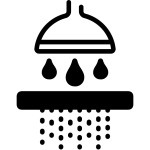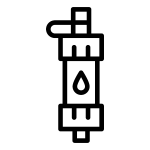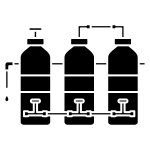Yellow faucet water is more than just unsightly — it can also be alarming. When you turn on your tap expecting clean, crystal-clear water and instead see a yellowish hue, your first instinct might be to worry. Is it safe to drink? Is your plumbing damaged? Is your water supply contaminated?
If you’ve ever asked yourself, “Why is my faucet water yellow?”, you’re not alone. This is a common issue that many households face. In this comprehensive guide by Cuoll, your trusted provider of high-quality water filters, water purifiers, bathtubs, and more, we’ll walk you through:
- The most common reasons for yellow tap water
- Whether it’s safe to drink or use
- How to test and fix yellow faucet water
- Prevention tips
- Recommended Cuoll products to help you get cleaner, safer water
Table of Contents
- Is Yellow Tap Water Safe?
- Why Is My Faucet Water Yellow? 10 Common Causes
- How to Test Yellow Water at Home
- How to Fix Yellow Faucet Water
- Prevention Tips for Yellow Water
- Best Cuoll Products to Treat Yellow Water
- When to Call a Professional
- Final Thoughts
Is Yellow Tap Water Safe?
In most cases, yellow tap water is not an immediate health hazard, but it can indicate underlying issues with your plumbing or water supply. The discoloration often results from:
- Rust in pipes
- Mineral buildup
- Disturbance in municipal water systems
However, yellow water should not be consumed without testing, especially if it appears suddenly or is accompanied by an odd taste or smell.
Why Is My Faucet Water Yellow? 10 Common Causes
Let’s look at the top reasons why your faucet water may turn yellow:
1. Rust and Corrosion in Pipes
Over time, old iron or galvanized steel pipes can corrode. This corrosion releases iron oxide (rust) into the water, causing a yellow, orange, or brown tint.
Tip: Yellow water from a single faucet usually points to localized pipe corrosion.
2. Disturbed Sediment in Municipal Water Lines
If your local water utility recently performed maintenance or there was a change in water pressure, sediment from the bottom of water mains may be stirred up and flow into your home’s plumbing.
3. High Levels of Iron or Manganese
Natural minerals like iron and manganese are often found in groundwater. High concentrations can cause yellow or tea-colored water, especially in homes with well water systems.
4. Water Heater Sediment Buildup
If the yellow water only comes from your hot water tap, the issue might lie in your water heater. Sediment can accumulate inside the tank and get flushed into your plumbing.
5. Municipal Water System Issues
Temporary changes in water chemistry or pipeline flushing by your water provider can lead to discolored water. It’s often harmless and clears up within hours, but you should always confirm with your utility company.
6. New Plumbing Installations or Repairs
New construction or plumbing work in your home or nearby can disrupt water flow and dislodge debris or rust particles into your tap water.
7. Well Water Contamination
Homes with private wells are more susceptible to natural mineral staining, especially after flooding, heavy rains, or lack of proper filtration.
8. Aging or Failing Water Filters
If you’re using an outdated or clogged filter, it may leak trapped contaminants back into the water, causing discoloration.
Cuoll Tip: Regularly replace your Cuoll water filters to maintain optimal water quality.
9. Bacterial Growth in Plumbing
In rare cases, bacterial growth in unused or poorly maintained pipes may cause yellow, cloudy, or foul-smelling water.
10. Lead or Other Heavy Metal Contamination
Though less common, older plumbing systems may leach heavy metals like lead, which can react with minerals in the water and cause yellowing.
How to Test Yellow Water at Home
Before panicking, test the water to understand the source of the problem. Here’s how:
✔️ Step 1: Determine the Scope
- Check if the yellow water comes from only one faucet or all.
- See if the discoloration affects only hot or cold water.
✔️ Step 2: Flush the Tap
- Let your faucet run for a few minutes. If the color clears, it may be a temporary issue like sediment.
✔️ Step 3: Collect a Sample
- Fill a clear glass with the yellow water. Check for:
- Sediment at the bottom
- Cloudiness
- Odor
✔️ Step 4: Use Water Testing Kits
Invest in a reliable home water test kit or call your local health department for recommendations. You can test for:
- Iron and manganese levels
- Bacterial contamination
- pH balance
- Hardness
- Lead and other heavy metals
How to Fix Yellow Faucet Water
Depending on the cause, here are the most effective ways to restore your water quality:
✅ 1. Install a Whole House Water Filter
A system like the Cuoll Whole House Filter removes sediment, rust, iron, and other contaminants before water reaches your faucets.
✅ 2. Use a Point-of-Use Water Purifier
If the yellow water is isolated to a few taps, consider installing Cuoll faucet water filters or under-sink purifiers.
✅ 3. Flush Your Plumbing
Running all faucets for 10–15 minutes can help clear temporary buildup or sediment.
✅ 4. Clean or Replace the Water Heater
If only hot water is yellow, drain and flush the tank to remove sediment. Replace aging units.
✅ 5. Replace Corroded Pipes
Galvanized iron pipes are notorious for rust buildup. Consider upgrading to PVC or PEX pipes.
✅ 6. Shock Chlorinate Your Well (for Well Users)
For homes with well water, periodic shock chlorination can kill bacteria and reduce discoloration.
Prevention Tips for Yellow Water
To avoid future issues, follow these expert tips:
- Install a Cuoll water filtration system customized for your needs
- Flush taps regularly if unused for extended periods
- Service your water heater every 6–12 months
- Test your water annually, especially for wells
- Replace old plumbing if you notice recurring yellow or brown water
- Stay informed about local water maintenance or pipeline changes
Best Cuoll Products to Treat Yellow Water
Here at Cuoll, we offer innovative, high-performance solutions to keep your water clean and safe.
⭐ Cuoll Whole House Water Filter
- Removes sediment, rust, iron, and chlorine
- Easy to install and maintain
- Great for homes with old plumbing or well water
⭐ Cuoll Faucet Water Purifier
- Affordable, compact, and powerful
- Attaches directly to kitchen or bathroom faucets
- Ideal for yellow water from specific taps
⭐ Cuoll Shower Filter
- Prevents yellowish tint in water affecting your hair and skin
- Great for families, especially in areas with hard water
⭐ Cuoll Bath Ball Filter – White Pro
- Filters bathwater from contaminants and metals
- Includes smart screen display to monitor filter life
- Perfect for protecting skin from rusty water
When to Call a Professional
If your yellow water persists despite DIY fixes, it’s time to seek expert help. Call a plumber or your local water authority if:
- Yellow water appears suddenly and heavily
- There’s a metallic taste or strange odor
- You suspect lead or bacterial contamination
- Water tests indicate unsafe levels of minerals or metals
Final Thoughts
So, why is my faucet water yellow? In most cases, it’s due to rust, sediment, or mineral content in your plumbing or water supply. While not always dangerous, yellow water is certainly unpleasant — and in some cases, a red flag for serious issues.
Fortunately, with the right knowledge and tools, you can diagnose the problem and choose a safe, effective solution. And that’s where Cuoll comes in.
From whole-house water filtration systems to affordable faucet and bath filters, Cuoll has everything you need to restore clarity and confidence to your tap water.
💧 Protect your health and home today — explore Cuoll’s full line of water treatment products!
Frequently Asked Questions (FAQs)
❓ Is yellow water safe to drink?
Not always. It’s best to test it for iron, manganese, and bacteria before consuming.
❓ Why is only my hot water yellow?
Likely due to sediment in your water heater. Try flushing the tank.
❓ Can a water filter remove yellow color from water?
Yes! A Cuoll sediment and iron filter can remove discoloration caused by rust and minerals.
❓ What if my neighbors also have yellow water?
That points to a municipal supply issue. Contact your local water provider.







